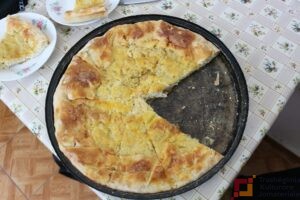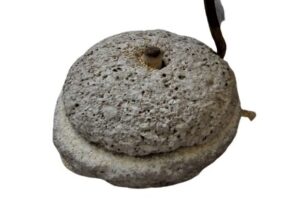“Heromillo” has derived its name from Greek, which means a hand-cranked mill used to grind or crush grain and corn kernels. Oral tradition has it that these hand-operated gristmills date back earlier than water mills. Milling wheat is a traditional practice passed down over generations to this day. This practice was born to meet the needs of daily life.
As a work tool, “Heromillo” comes in: 2 stone cylinders sized 50-60 cm in diameter and 10-12 cm thick. The stone is a special and hard flint made up of several pieces of flint as if naturally welded into a homogenous structure. The lower (bottom) stone cylinder is slightly thicker with a spindle passing through the center. On top, the other stone cylinder is well-fitted with a bigger hole in the center, where the grain is manually poured in. The upper (top) cylinder has also a cog that supports the pointed crank used to rotate it. So, the stone weight and the friction between the two stones, cause the grain to be crushed and ground. The more this process goes over and over, the finer the flour comes out.
Shaping the two stone cylinders, fixing the spindle, and fitting them tightly, requires a highly intricate technique which is a business of just a skillful master. In older times, most families would keep heromillo-s made to order from such renowned masters.
The crushed wheat is traditionally used to cook “Byrjam” in a baking pan with butter, cheese, and herbs, a very flavorsome bread-free dish.
On January 1st, all orthodox Christians celebrate the name of St. Basil. As a tradition on this occasion, they cook with wheat crushed in heromillo, the characteristic “Vasilopita” bread or cake. This dish is prepared with thin pastry sheets, crushed wheat, butter, and cheese, and the surface is brushed over with egg wash to give an attractive color and a shiny finish. A gold coin was hidden inside before baking it and after slicing and rolling it, the family members chose a slice. Whoever happens to find the gold coin in their slice, is said to be blessed and to receive good luck for the coming year.
They say that “Vasilopita” bread with crushed wheat was cooked for another reason: wishing a new year of prosperity and abundance in wheat harvesting (this is related to the old Greek papers the exact source of which has remained unknown).
As the tradition goes, when the family is awaiting the Vasilopita, the lady of the house wishes her family:
Blessings and good luck!



